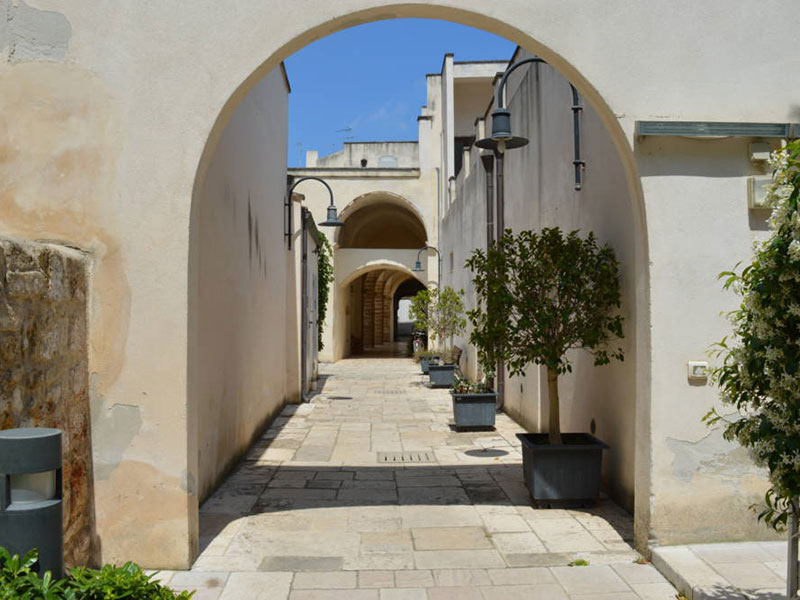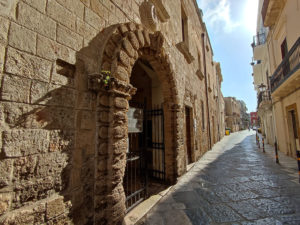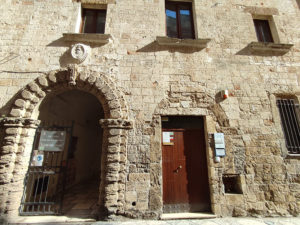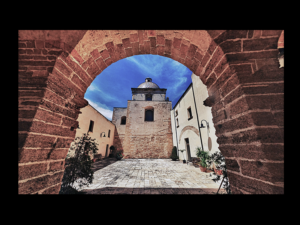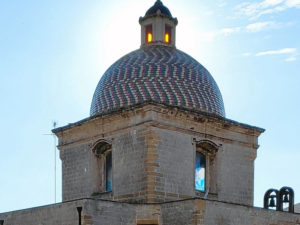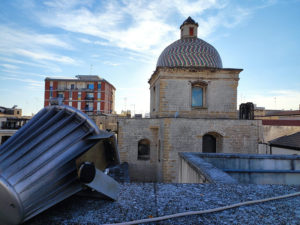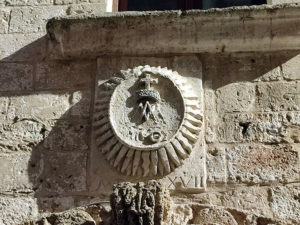Indirizzo
Via dei del Balzo, 10, 72100 Brindisi BR
GPS
40.6393595, 17.9443566
Scuole Pie dei Padri Scolopi, Accademia degli Erranti, XVII sec.
Le prime scuole pubbliche della città.
Sino alla fine dell’800 la strada che va da via San Benedetto sino al Duomo si chiamava delle Scuole Pie, poi intitolata nel primo tratto a Santa Barbara – dalla presenza di un’antica chiesa, già in rovina nel XVII sec. – nonché a Giovanni Tarantini, presbitero ed archeologo brindisino del XIX sec., che qui aveva casa e che molto si prodigò per la tutela dei beni culturali della città.
Il complesso delle Scuole Pie sorge laddove un tempo era il convento dei Padri Celestini, che nel 1659 fu acquistato da Monsignor Francesco De Estrada, arcivescovo, che lo fece restaurare e lo assegnò, dotandolo in rendite, ai Padri seguaci della regola di S. Giuseppe Calasanzio (N. Vacca), meglio conosciuti come Padri Scolopi. L’ordine religioso degli Scolopi («chierici regolari poveri della Madre di Dio delle Scuole pie»), il cui fine principale è l’educazione e l’istruzione della gioventù, fu fondato a Roma da S. Giuseppe Calasanzio nel 1617 e approvato nel 1621.
Le Scuole Pie furono, quindi, le prime scuole pubbliche della città, sebbene già vi fossero delle scuole private. Qui i Padri insegnavano i primi rudimenti della lingua e delle scienze e istituirono anche l’Accademia degli Erranti nella quale si esercitava la gioventù brindisina (N. Vacca). L’Accademia degli Erranti, che aveva carattere ascetico, è apparsa per la prima volta a Brescia, istituita nel 1619 da un gruppo di intellettuali, i quali nel 1635 pubblicavano il suo statuto dal titolo “Capitoli e Ordini per l’Accademia degli Erranti di Brescia”. Il suo scopo era l’isercitamenti di lettere, d’arme e di musica.
La chiesa delle Scuole Pie, fatta realizzare dal De Estrada, con la sua cupola rivestita con mattonelle ceramiche policrome, da principio era intitolata a S. Angelo, poi fu dedicata a S. Michele Arcangelo. Al suo interno, al di sotto della pavimentazione, durante lavori di restauro di alcuni anni fa fu rinvenuto un sepolcreto. L’attiguo cortile conserva i locali dell’ex convento divenuto nei secoli dormitorio, oltre che scuola, poi anche carcere ed oggi tra i beni gestiti dall’Amministrazione Comunale, con sede della collezione pittorica Armando Scivales, illustre artista brindisino del ‘900. Attualmente presso l’immobile ha sede l’Associazione Brindisi e le Antiche Strade.
Pious Schools of the Piarist Fathers, Accademia degli Erranti, 17th century,
First public schools in the city.
Until the end of the 19th century, the road that goes from Via San Benedetto to the Cathedral was called the Scuole Pie, then in the first section entitled to Santa Barbara – from the presence of an ancient church, already in ruins in the seventeenth century. – as well as to Giovanni Tarantini, a priest and archaeologist from Brindisi of the nineteenth century, who had a home here and who did a great deal to protect the cultural heritage of the city.
The complex of the Pious Schools stands where once was the convent of the Celestine Fathers, which in 1659 was purchased by Monsignor Francesco De Estrada, archbishop, who had it restored and assigned it, providing it with income, to the Fathers who followed the rule of St. Joseph Calasanzio (N. Vacca), better known as the Scolopi Fathers. The religious order of the Piarists (“poor regular clerics of the Mother of God of the Pious Schools”), whose main purpose is the education and instruction of the youth, was founded in Rome by St. Joseph Calasanz in 1617 and approved in 1621.
The Pious Schools were, therefore, the first public schools in the city, although there were already private schools. Here the Fathers taught the first rudiments of language and sciences and also established the Accademia degli Erranti in which the Brindisi youth (N. Vacca) practiced. The Accademia degli Erranti, which had an ascetic character, appeared for the first time in Brescia, established in 1619 by a group of intellectuals, who in 1635 published its statute entitled “Chapters and Orders for the Accademia degli Erranti of Brescia “. Its purpose was the training of letters, arms and music.
The church of the Scuole Pie, commissioned by De Estrada, with its dome covered with polychrome ceramic tiles, was initially dedicated to S. Angelo, then it was dedicated to S. Michele Arcangelo. Inside, under the pavement, a burial ground was found during restoration work a few years ago. The adjacent courtyard preserves the premises of the former convent which over the centuries became a dormitory, as well as a school, then also a prison and today among the assets managed by the Municipal Administration, with the seat of the Armando Scivales painting collection, an illustrious 20th century artist from Brindisi. The Brindisi and the Ancient Roads Association is currently located in the building.

